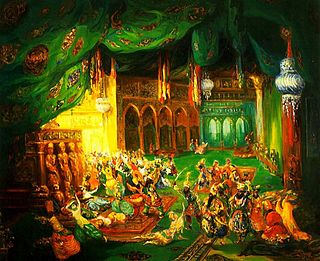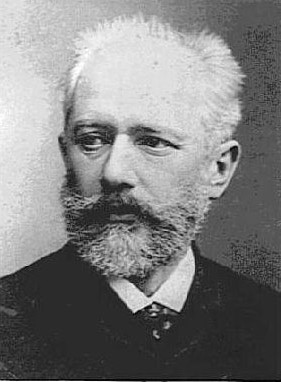
Samuel Osmond Barber II was an American composer, pianist, conductor, baritone, and music educator, and one of the most celebrated composers of the mid-20th century. Principally influenced by nine years' composition studies with Rosario Scalero at the Curtis Institute and more than 25 years' study with his uncle, the composer Sidney Homer, Barber's music usually eschewed the experimental trends of musical modernism in favor of traditional 19th-century harmonic language and formal structure embracing lyricism and emotional expression. However, he adopted elements of modernism after 1940 in some of his compositions, such as an increased use of dissonance and chromaticism in the Cello Concerto (1945) and Medea's Dance of Vengeance (1955); and the use of tonal ambiguity and a narrow use of serialism in his Piano Sonata (1949), Prayers of Kierkegaard (1954), and Nocturne (1959).

Ferdinand Rudolph von Grofé, known as Ferde Grofé was an American composer, arranger, pianist, and instrumentalist. He is best known for his 1931 five-movement symphonic poem, Grand Canyon Suite, and for orchestrating George Gershwin's Rhapsody in Blue for its 1924 premiere.

Albert Charles Paul Marie Roussel was a French composer. He spent seven years as a midshipman, turned to music as an adult, and became one of the most prominent French composers of the interwar period. His early works were strongly influenced by the Impressionism of Debussy and Ravel, while he later turned toward neoclassicism.

Samuel Coleridge-Taylor was a British composer and conductor. Of mixed-race descent, Coleridge-Taylor achieved such success that he was referred to by white musicians in New York City as the "African Mahler" when he had three tours of the United States in the early 1900s. He was particularly known for his three cantatas on the epic 1855 poem The Song of Hiawatha by American Henry Wadsworth Longfellow. Coleridge-Taylor premiered the first section in 1898, when he was 23. He married an Englishwoman, Jessie Walmisley, and both their children had musical careers. Their son, Hiawatha, adapted his father's music for a variety of performances. Their daughter, Avril Coleridge-Taylor, became a composer-conductor.

La source is a ballet in three acts/four scenes with a score composed by Léo Delibes and Ludwig Minkus which was premiered in Paris in 1866 with choreography by Arthur Saint-Léon. In 1878 in Vienna it was called Naïla, die Quellenfee.

Scheherazade, also commonly Sheherazade, Op. 35, is a symphonic suite composed by Nikolai Rimsky-Korsakov in 1888 and based on One Thousand and One Nights.
Le Baiser de la fée is a neoclassical ballet in one act and four scenes composed by Igor Stravinsky in 1928 and revised in 1950 for George Balanchine and the New York City Ballet. Based on Hans Christian Andersen's short story Isjomfruen, the work is an homage to Pyotr Ilyich Tchaikovsky, for the 35th anniversary of the composer's death. Stravinsky elaborated several melodies from early piano pieces and songs by Tchaikovsky in his score. A commission by Ida Rubinstein from 1927, the ballet was choreographed by Bronislava Nijinska and premiered in Paris on 27 November 1928.

Symphonic Dances, Op. 45, is an orchestral suite in three movements completed in October 1940 by Russian composer Sergei Rachmaninoff. It is his final major composition, and his only piece written in its entirety while living in the United States.
Medea, Op. 23, (1946) is a ballet suite by American composer Samuel Barber. It was commissioned by the Ditson Fund of Columbia University for Martha Graham and was premiered on 10 May 1946, at Columbia University's McMillin Theater, New York City. The ballet was originally called Serpent Heart, but the work was revised in 1947 and retitled Cave of the Heart. Costumes were designed by Edythe Gilfond and the set was created by Isamu Noguchi. The original cast list included Graham, Erick Hawkins, Yuriko, May O'Donnell, and other members of the Martha Graham Dance Company.
Anthony Vincent Benedictus Collins was a British composer and conductor. He scored around 30 films in the US and the UK between 1937 and 1954, and composed the British light music classic Vanity Fair in 1952. His Decca recordings of the seven Sibelius symphonies was the second cycle by a single conductor and orchestra released.

Norman Houston O'Neill was an English composer and conductor of Irish background who specialised largely in works for the theatre.
Samuel Barber's Essay for Orchestra, Op. 12, completed in the first half of 1938, is an orchestral work in one movement. It was given its first performance by Arturo Toscanini with the NBC Symphony Orchestra on November 5, 1938 in New York in a radio broadcast concert in which the composer's Adagio for Strings saw its first performance. It lasts around 8 minutes and is dedicated "To C.E." The essay is now known as the First Essay for Orchestra after Barber wrote his Second Essay for Orchestra in 1942. He also wrote a Third Essay in 1978.

Robert Augustine Irving, DFC*, was a British conductor whose reputation was mainly as a ballet conductor.

Pyotr Ilyich Tchaikovsky was a Russian composer especially known for three very popular ballets: Swan Lake, The Sleeping Beauty and The Nutcracker. He also composed operas, symphonies, choral works, concertos, and various other classical works. His work became dominant in 19th century Russia, and he became known both in and outside Russia as its greatest musical talent.

The Piano Sonata in E-flat minor, Op. 26, by the American composer Samuel Barber, was commissioned for the twenty-fifth anniversary of the League of Composers by American songwriters Irving Berlin and Richard Rodgers. Composed from 1947 to 1949, the sonata is in four movements. It was first performed by Vladimir Horowitz in December 1949 in Havana, Cuba, followed by performances in Washington, D.C. and New York City in January 1950. The sonata is regarded as a cornerstone of American piano literature and one of Barber's most significant achievements. Critics hailed it as a defining moment in mid-20th-century music, with The New York Times describing it as the "first sonata truly to come of age by an American composer of this period".
Symphony No. 2, Op. 19 is a three-movement work for orchestra by the American composer Samuel Barber. The 25-minute work was originally written in 1944. The work underwent many revisions and was finally published in 1950. The original manuscript was withdrawn by Barber in 1964. He ordered that G. Schirmer destroy the original manuscript and all scores in their library. The work remained unpublished for many years until 1984 when a set of parts turned up in a warehouse in England. Renewed interest in Barber's work led to a 1990 reprint of the 1950 edition.

Kenneth Alwyn Wetherell was a British conductor, composer, and writer. Described by BBC Radio 3 as "one of the great British musical directors", Alwyn was known for his many recordings, including with the London Symphony Orchestra on Decca's first stereophonic recording of Tchaikovsky's 1812 Overture. He was also known for his long association with BBC Radio 2's orchestral live music programme Friday Night is Music Night, appearing for thirty years as a conductor and presenter, and for his contribution to British musical theatre as a prolific musical director in the 1950s and 1960s. He was a Fellow of the Royal Academy of Music and married the actress Mary Law in 1960. His website and the first volume of his memoirs A Baton in the Ballet and Other Places were both published in 2015. The second volume Is Anyone Watching? was published in 2017.
The Third Essay for Orchestra, Op. 47, is a short orchestral work composed by Samuel Barber in 1978. The score is dedicated to Audrey Sheldon.
Cave of the Heart is a one-act ballet choreographed by Martha Graham to music by Samuel Barber. It was first performed on May 10, 1946, with the title Serpent Heart, at the second annual Festival of Contemporary American Music in the McMillin Theater of Columbia University. Serpent Heart was commissioned by the festival sponsor, The Alice M. Ditson Fund.

Soirées musicales,, Op. 9, is a suite of five movements by Benjamin Britten, using music composed by Gioachino Rossini. The suite, first performed in 1937, derives its title from Rossini's collection of the same name, dating from the early 1830s, from which Britten drew much of the thematic material.











